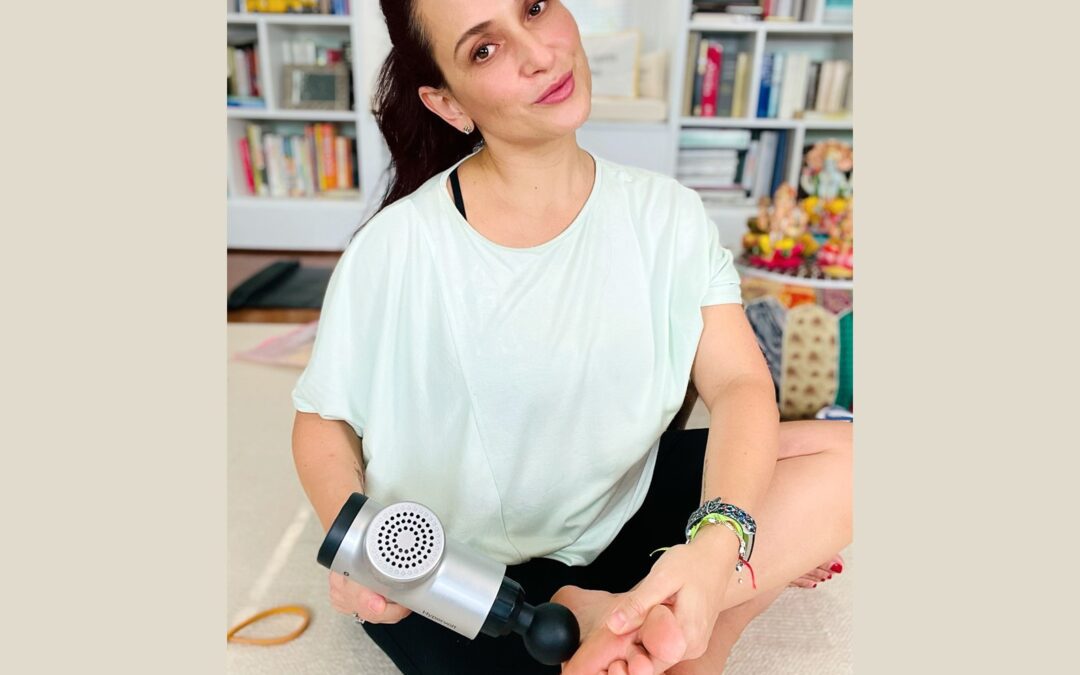After a few games of pickleball, a new activity for me, my knee started hurting. It had gotten so bad I was limping on and off the court. I imagined me in a brace or having to get a knee replacement. My brain went wild. But I wanted to play pickleball. When I got home I pulled out my percussive gun and massaged around the knee, calf, foot and thigh. Literally overnight, the pain disappeared. I continue to play pickleball without a brace, without medication and without a trip to a medical professional.
What happened to my leg when I used my “gun,” was that the soft tissue surrounding the knee was stiff or misaligned. Releasing the fascia (soft tissue), getting the blood flowing to the area and bringing the joint and muscles back where they should be, relieved the pain. To ensure my joint stays pain-free I have developed exercises I do a couple of times a week. I use my gun almost daily on the area and regularly stretch.
These tools that have been used by chiropractors, physical therapists and other personalized medicine practitioners, now have become trendy in gyms.
Last month at a conference I attended a session led by a personal trainer and a physical therapist. The two-hour class was about the science behind using percussive instruments like my massage gun for longevity, recovery and durability. The importance of the health of our fascia has become mainstream.
A percussion massager uses quick pulses designed to reach deeply into sore tissues and muscles. The soft rubber mallet also gives pointed contact to areas of particular concern. Different attachments come standard with most, if not all, massage guns, helping you target smaller areas more closely, penetrating the deep tissues.
What is Fascia?
According to Johns Hopkins University, fascia is a thin casing of connective tissue that surrounds and holds every organ, blood vessel, bone, nerve fiber and muscle in place. The tissue does more than provide internal structure; fascia has nerves that make it almost as sensitive as skin. When stressed, it tightens up.
Although fascia looks like one sheet of tissue, it’s actually made up of multiple layers with liquid in between called hyaluronan. It’s designed to stretch as you move. But there are certain things that cause fascia to thicken and become sticky. When it dries up and tightens around muscles, it can limit mobility and cause painful knots to develop. Until recently, this network of tissue throughout the body received very little attention despite its major role in every move you make.
Benefits of Using Regularly
I can keep my body pain-free between my monthly massage sessions, and its purchase was less than it costs to get a massage. I also don’t have to bend or get down on the floor as I do with a foam roller which can also be used to help stretch and release restricted fascia so the muscles and joints under them can move freely.
What I was most surprised about was the research that shows how using a massage gun can improve sleep through regular use. According to Chris Nentarz, Therapy Corp., using a percussive gun before bed increases sleep efficiency by 70 percent. Eighty-seven percent of participants in the study fell asleep faster.
Other benefits include:
- Thickened connective tissue and fascia becomes relaxed.
- Adhesions and internal scar tissue, present after injuries or surgery breaks down.
- Circulation increases.
- Muscle fiber elongates.
- Range of movement increases.
Jana Lerbach, wellness coach, who has chronic glute and low back pain, has been using a percussive gun on herself and with her clients for years. “If your trigger points are not released and your range of motion and mobility are not good, doing cardio, sports or lifting weights will most likely lead to injury,” she said. “You can’t lose weight, run or do competitive exercise well if you can’t move. Your balance is also affected.”
When Lerbach returned from a stressful trip she chose to get back in shape with a personal trainer. “He used a gun head-to-toe on me the first four sessions,” she said. “I needed corrective movements. I was blocked.”
Lerbach was no stranger to the use of percussive guns. “My first awareness of them was about five years ago when I did foot specialist training. The doctor who was teaching said the best way to help ailments of the feet was to use one regularly on the feet and calves for better mobility and less pain.”
Long-time Hill resident Dee Atwell, who has stenosis in her back and arthritis, has been using her gun for about two years. “I use it almost nightly to help me walk upright. I also use it at different speeds on different parts of my body,” she said. “I feel my way through the process.” For example, if she does something like yard work then she pays attention to her arms, shoulders and upper back even if they are not sore.
“I have given five away to friends as gifts including to a 73-year-old and an 18-year-old. They all thanked me.”
How to Use
Anyone can benefit from its use. A few things to be aware of: don’t use if you have a wound, have nerve disorders or have bleeding disorders. Do not use over bony areas. Be sure to consult your medical professional if you have any uncertainties.
Lerbach, who uses it with every client, advises starting slowly. “I rarely use the high speed. Don’t use force and don’t overuse. Most areas don’t need more than 30 seconds to lengthen fascia. Move-in different directions because soft tissue is not linear.”
“Massaging my feet and calves is a non-negotiable healthy habit. It’s like brushing my teeth.”
To contact Jana Lerbach, JL Wellness Academy, call or text: 202-601-0425. Or email: [email protected].
For more information check out therabody.com, or search percussive guns on the web.
Pattie Cinelli is a health and fitness professional and journalist who has been writing her column for more than 20 years. She focuses on holistic and leading-edge ways to stay healthy, get well and connect with your true self. Please email her at: [email protected].

